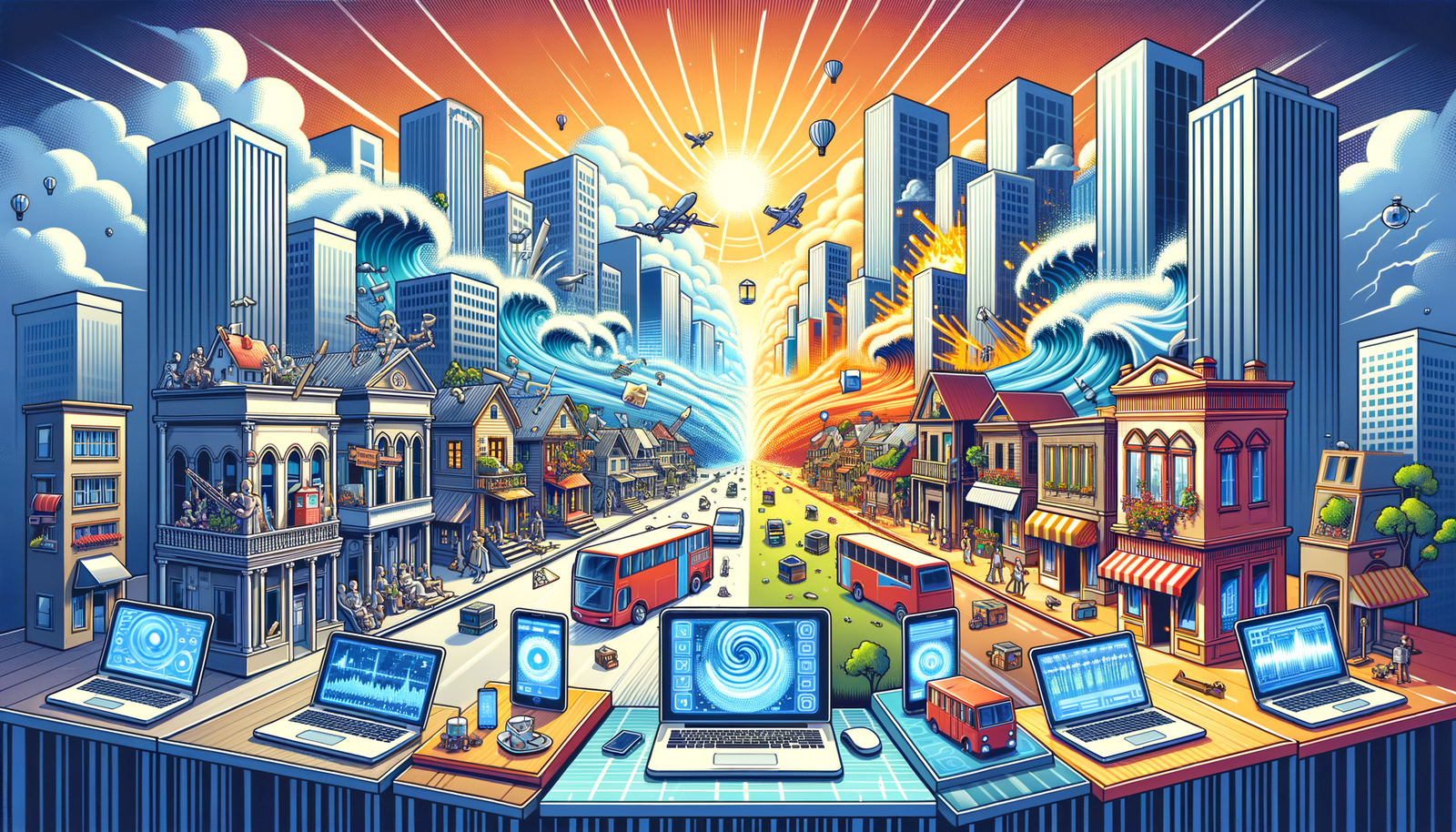Your Cart is Empty
Customer Testimonials
-
"Great customer service. The folks at Novedge were super helpful in navigating a somewhat complicated order including software upgrades and serial numbers in various stages of inactivity. They were friendly and helpful throughout the process.."
Ruben Ruckmark
"Quick & very helpful. We have been using Novedge for years and are very happy with their quick service when we need to make a purchase and excellent support resolving any issues."
Will Woodson
"Scott is the best. He reminds me about subscriptions dates, guides me in the correct direction for updates. He always responds promptly to me. He is literally the reason I continue to work with Novedge and will do so in the future."
Edward Mchugh
"Calvin Lok is “the man”. After my purchase of Sketchup 2021, he called me and provided step-by-step instructions to ease me through difficulties I was having with the setup of my new software."
Mike Borzage
Design Software History: Advancements in Software for Disaster-Resilient Urban Planning: A Historical and Technological Perspective
November 26, 2024 7 min read


Introduction to Disaster-Resilient Urban Planning
Disaster-resilient urban planning refers to the strategic approach of designing and managing urban environments to withstand and quickly recover from natural disasters. As the frequency and intensity of natural calamities like earthquakes, floods, hurricanes, and wildfires increase globally, largely due to climate change and rapid urbanization, the resilience of cities has become a paramount concern. Urban areas, often densely populated and economically significant, are particularly vulnerable to the devastating impacts of such events. The disruption of infrastructure, loss of life, and economic setbacks highlight the urgent need for robust planning strategies.
The importance of disaster-resilient urban planning lies in its ability to minimize risk and enhance the safety and well-being of urban populations. It involves integrating risk assessment, land-use planning, building regulations, and emergency preparedness into the urban development process. By anticipating potential disasters and incorporating mitigation measures, cities can reduce vulnerability and improve their capacity to respond and recover. This proactive approach not only protects lives and property but also ensures the continuity of critical functions and services during and after disasters.
In this context, software solutions play a crucial role in enhancing urban planning resilience. Advanced technologies enable planners to analyze complex data, simulate disaster scenarios, and collaborate effectively with stakeholders. Software tools facilitate the visualization of risks, optimization of resource allocation, and development of evidence-based strategies. By leveraging these technologies, urban planners can make informed decisions that significantly improve a city's ability to cope with natural disasters. The integration of software solutions into urban planning represents a significant advancement in building resilient cities capable of facing the challenges posed by an increasingly volatile natural environment.
Evolution of Software Solutions for Urban Planning
The evolution of software solutions in urban planning has been marked by significant milestones that have transformed the field. In the early days, urban planning relied heavily on manual drafting and physical models, which were time-consuming and limited in scope. The advent of Computer-Aided Design (CAD) systems in the 1960s revolutionized this process. Companies like Autodesk, founded by John Walker in 1982, introduced AutoCAD, one of the first widely used CAD programs. AutoCAD allowed planners and architects to create precise digital drawings, greatly enhancing efficiency and accuracy in design.
Following the introduction of CAD, the integration of Geographic Information Systems (GIS) became a pivotal development. GIS technology, pioneered by Esri under the leadership of Jack Dangermond since 1969, enabled the analysis and visualization of spatial data in ways that were previously impossible. Esri's ArcGIS platform allowed urban planners to overlay various datasets—such as population demographics, infrastructure, environmental hazards, and more—onto geographical maps. This integration facilitated a deeper understanding of spatial relationships and patterns critical for informed decision-making in urban development.
As natural disasters became more frequent and severe, there was a growing need for specialized software focusing on disaster resilience. This led to the rise of tools designed specifically to model and mitigate the impacts of natural hazards. Notable examples include Esri's ArcGIS enhancements for disaster management and PTV Group's VISSIM, a microscopic traffic flow simulation software developed to optimize evacuation routes and emergency response scenarios. PTV Group, founded by Michael Hahn in 1979, contributed significantly to transportation planning with VISSIM, allowing for detailed simulation of vehicular and pedestrian movements under various conditions.
The evolution continued with the development of integrated platforms that combined CAD, GIS, and simulation capabilities. Companies like Bentley Systems, founded by the Bentley brothers in 1984, introduced software like MicroStation, which supported 3D modeling and infrastructure design with an emphasis on interoperability. The progression from basic digital drafting to complex, data-rich modeling tools reflects the industry's response to the growing complexity of urban environments and the need for resilient planning solutions.
Current Technologies and Tools in Disaster-Resilient Planning
Today, urban planners have access to a wide array of advanced technologies and tools that enhance disaster-resilience efforts. Key among these are Geographic Information Systems (GIS), which are instrumental in risk mapping and analysis. GIS platforms like Esri's ArcGIS enable planners to collect, manage, and analyze spatial data related to natural hazards, infrastructure, and demographics. By layering different datasets, planners can identify vulnerable areas, assess potential impacts of disasters, and prioritize mitigation efforts. GIS tools facilitate the visualization of complex information in an accessible format, supporting evidence-based decision-making.
Simulation tools for disaster scenarios are another critical component. Software such as HAZUS, developed by the Federal Emergency Management Agency (FEMA) and the National Institute of Building Sciences, allows planners to model the effects of earthquakes, hurricanes, floods, and other disasters. These simulations consider factors like building types, soil conditions, and population distribution to estimate potential damages and casualties. Similarly, software like Delft3D, developed by Deltares, specializes in modeling water-related disasters, such as floods and tsunamis, providing valuable insights into their potential impact on urban areas.
Collaborative platforms have emerged to enable real-time data sharing among stakeholders, which is essential for coordinated disaster-resilience planning. Tools like Bentley Systems' ProjectWise facilitate collaboration among architects, engineers, planners, and government agencies by providing a centralized platform for sharing designs, models, and data. These platforms enhance communication, reduce redundancies, and ensure that all stakeholders have access to the latest information.
The capabilities of modern software in disaster-resilient planning can be summarized as follows:
- Risk Mapping and Analysis: GIS tools help identify and visualize areas at risk, supporting targeted interventions.
- Disaster Simulation: Modeling tools predict the potential impacts of various disaster scenarios, informing preparedness strategies.
- Real-Time Data Sharing: Collaborative platforms ensure that all stakeholders have access to up-to-date information for coordinated action.
- Infrastructure Design Integration: Software integrates infrastructure planning with disaster resilience considerations.
- Resource Optimization: Planning tools help allocate resources efficiently for maximum impact in disaster mitigation.
These technologies not only enhance the technical aspects of urban planning but also support policy development, community engagement, and emergency response planning. By leveraging these tools, cities can develop comprehensive strategies that address both immediate risks and long-term resilience goals.
Challenges and Future Directions
Despite significant advancements, integrating software into disaster-resilient urban planning presents several challenges. One of the foremost issues is data collection and management. Accurate and detailed data is the backbone of effective planning tools; however, collecting such data can be hindered by various factors. Limitations may arise from insufficient data infrastructure, especially in developing regions, leading to gaps that affect the reliability of risk assessments. Additionally, data may be siloed within different government agencies or organizations, making it difficult to access and integrate. Privacy concerns and regulatory restrictions can also limit the availability of critical information necessary for comprehensive analysis.
Interoperability between different software systems is another significant challenge. Urban planning often requires the use of multiple software platforms, each with its own data formats and standards. For instance, integrating outputs from a hydraulic modeling tool with a GIS platform may require complex data conversion processes. This lack of standardization can lead to inefficiencies, increased costs, and potential errors in planning. Proprietary software solutions may further complicate interoperability due to closed systems that do not easily share data with other platforms.
Looking ahead, the incorporation of artificial intelligence (AI) and machine learning (ML) presents promising future directions in disaster-resilient urban planning. AI and ML algorithms can analyze vast datasets to identify patterns and predict future disaster scenarios with greater accuracy. For example, machine learning models can improve flood prediction by analyzing historical weather data, topography, and land use patterns. Companies like IBM, with its Watson platform, and researchers like Geoffrey Hinton have been pioneering AI technologies that could be adapted for use in urban planning and disaster resilience.
Another trend is the potential for integrating community feedback and participatory planning through technology. Mobile applications and online platforms can engage citizens directly, allowing them to report hazards, provide local knowledge, and participate in decision-making processes. This participatory approach fosters a sense of ownership and can enhance the effectiveness of resilience strategies by incorporating diverse perspectives. Technologies like geospatial social networking platforms facilitate this engagement, enabling real-time communication between the public and planners.
To overcome current challenges and leverage future opportunities, there is a need for:
- Standardized Data Protocols: Developing common data standards to improve interoperability between software systems.
- Investment in Data Infrastructure: Enhancing data collection and management capabilities, particularly in underserved regions.
- Collaboration Between Stakeholders: Encouraging partnerships among software developers, urban planners, government agencies, and communities.
- Embracing Open-Source Solutions: Utilizing open-source software to reduce costs and improve adaptability.
- Continuous Innovation: Supporting research and development in new technologies that enhance disaster resilience.
These steps can help address existing obstacles and pave the way for more resilient urban environments. The integration of cutting-edge technologies, coupled with collaborative efforts, will be essential in meeting the evolving challenges of disaster-resilient urban planning.
Conclusion
In summary, software solutions are integral to advancing disaster-resilient urban planning. From the historical milestones of CAD and GIS integration to the current use of simulation tools and collaborative platforms, technology has continuously enhanced the capacity of urban planners to anticipate and mitigate the impacts of natural disasters. The growing complexity of urban environments and the increasing threat of climate-related events necessitate the adoption of advanced, data-driven approaches.
The challenges faced, including data collection issues and software interoperability, highlight the need for ongoing efforts to improve and adapt these tools. The future of disaster-resilient urban planning lies in embracing innovations such as artificial intelligence and fostering greater community participation through technology. By addressing these challenges and leveraging new advancements, urban planners and software developers can collaborate to build cities that are not only smarter but also safer and more sustainable.
The imperative is clear: continuous innovation and collaboration are essential to address the evolving challenges posed by climate change and urbanization. Urban planners, policymakers, software developers, and communities must work together to create resilient urban spaces. Through concerted efforts and the strategic use of technology, we can enhance the ability of our cities to withstand natural disasters, protect lives and property, and ensure a prosperous future for all inhabitants.
Also in Design News

Leveraging Predictive Design and Machine Learning for Future-Ready Solutions
November 26, 2024 10 min read
Read More
ZBrush Tip: Maximizing Sculpting Precision with ZBrush Morph Targets: Essential Tips and Techniques
November 25, 2024 2 min read
Read More
V-Ray Tip: Mastering V-Ray Shadow Catcher for Seamless 3D Compositing
November 25, 2024 2 min read
Read MoreSubscribe
Sign up to get the latest on sales, new releases and more …


